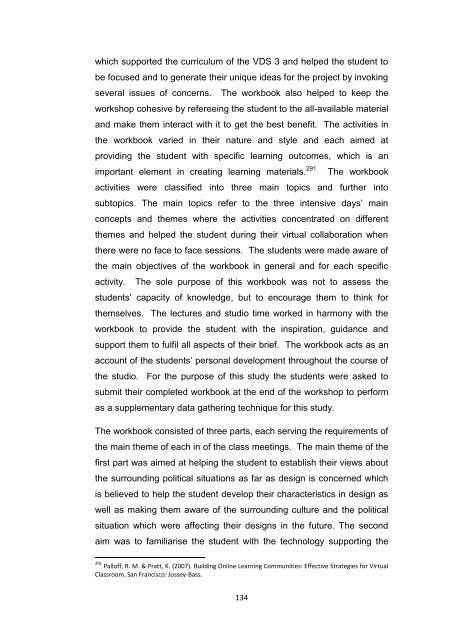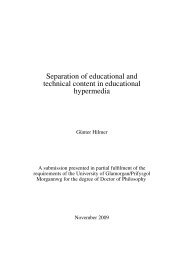framework for the implementation of a virtual design studio model in ...
framework for the implementation of a virtual design studio model in ...
framework for the implementation of a virtual design studio model in ...
Create successful ePaper yourself
Turn your PDF publications into a flip-book with our unique Google optimized e-Paper software.
which supported <strong>the</strong> curriculum <strong>of</strong> <strong>the</strong> VDS 3 and helped <strong>the</strong> student to<br />
be focused and to generate <strong>the</strong>ir unique ideas <strong>for</strong> <strong>the</strong> project by <strong>in</strong>vok<strong>in</strong>g<br />
several issues <strong>of</strong> concerns. The workbook also helped to keep <strong>the</strong><br />
workshop cohesive by referee<strong>in</strong>g <strong>the</strong> student to <strong>the</strong> all-available material<br />
and make <strong>the</strong>m <strong>in</strong>teract with it to get <strong>the</strong> best benefit. The activities <strong>in</strong><br />
<strong>the</strong> workbook varied <strong>in</strong> <strong>the</strong>ir nature and style and each aimed at<br />
provid<strong>in</strong>g <strong>the</strong> student with specific learn<strong>in</strong>g outcomes, which is an<br />
important element <strong>in</strong> creat<strong>in</strong>g learn<strong>in</strong>g materials. 291 The workbook<br />
activities were classified <strong>in</strong>to three ma<strong>in</strong> topics and fur<strong>the</strong>r <strong>in</strong>to<br />
subtopics. The ma<strong>in</strong> topics refer to <strong>the</strong> three <strong>in</strong>tensive days‟ ma<strong>in</strong><br />
concepts and <strong>the</strong>mes where <strong>the</strong> activities concentrated on different<br />
<strong>the</strong>mes and helped <strong>the</strong> student dur<strong>in</strong>g <strong>the</strong>ir <strong>virtual</strong> collaboration when<br />
<strong>the</strong>re were no face to face sessions. The students were made aware <strong>of</strong><br />
<strong>the</strong> ma<strong>in</strong> objectives <strong>of</strong> <strong>the</strong> workbook <strong>in</strong> general and <strong>for</strong> each specific<br />
activity. The sole purpose <strong>of</strong> this workbook was not to assess <strong>the</strong><br />
students‟ capacity <strong>of</strong> knowledge, but to encourage <strong>the</strong>m to th<strong>in</strong>k <strong>for</strong><br />
<strong>the</strong>mselves. The lectures and <strong>studio</strong> time worked <strong>in</strong> harmony with <strong>the</strong><br />
workbook to provide <strong>the</strong> student with <strong>the</strong> <strong>in</strong>spiration, guidance and<br />
support <strong>the</strong>m to fulfil all aspects <strong>of</strong> <strong>the</strong>ir brief. The workbook acts as an<br />
account <strong>of</strong> <strong>the</strong> students‟ personal development throughout <strong>the</strong> course <strong>of</strong><br />
<strong>the</strong> <strong>studio</strong>. For <strong>the</strong> purpose <strong>of</strong> this study <strong>the</strong> students were asked to<br />
submit <strong>the</strong>ir completed workbook at <strong>the</strong> end <strong>of</strong> <strong>the</strong> workshop to per<strong>for</strong>m<br />
as a supplementary data ga<strong>the</strong>r<strong>in</strong>g technique <strong>for</strong> this study.<br />
The workbook consisted <strong>of</strong> three parts, each serv<strong>in</strong>g <strong>the</strong> requirements <strong>of</strong><br />
<strong>the</strong> ma<strong>in</strong> <strong>the</strong>me <strong>of</strong> each <strong>in</strong> <strong>of</strong> <strong>the</strong> class meet<strong>in</strong>gs. The ma<strong>in</strong> <strong>the</strong>me <strong>of</strong> <strong>the</strong><br />
first part was aimed at help<strong>in</strong>g <strong>the</strong> student to establish <strong>the</strong>ir views about<br />
<strong>the</strong> surround<strong>in</strong>g political situations as far as <strong>design</strong> is concerned which<br />
is believed to help <strong>the</strong> student develop <strong>the</strong>ir characteristics <strong>in</strong> <strong>design</strong> as<br />
well as mak<strong>in</strong>g <strong>the</strong>m aware <strong>of</strong> <strong>the</strong> surround<strong>in</strong>g culture and <strong>the</strong> political<br />
situation which were affect<strong>in</strong>g <strong>the</strong>ir <strong>design</strong>s <strong>in</strong> <strong>the</strong> future. The second<br />
aim was to familiarise <strong>the</strong> student with <strong>the</strong> technology support<strong>in</strong>g <strong>the</strong><br />
291 Pall<strong>of</strong>f, R. M. & Pratt, K. (2007). Build<strong>in</strong>g Onl<strong>in</strong>e Learn<strong>in</strong>g Communities: Effective Strategies <strong>for</strong> Virtual<br />
Classroom. San Francisco: Jossey-Bass.<br />
134



